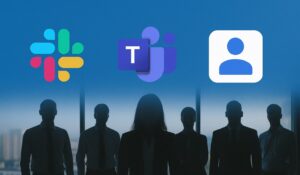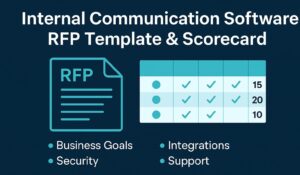Choosing the right internal communication tools isn’t just about preference – it’s about ensuring every employee, from headquarters to the frontline, gets the information they need, when and how they need it. Employees today expect timely updates through the medium they use most.
Deskless employees make up 80% of the global workforce yet receive only 1% of enterprise software investment. No wonder the internal communications software market, valued at $11.67 billion in 2024, is projected to reach $26.11 billion by 2034. The demand for real-time, personalized, and mobile-native communication tools is driving a wave of innovation and fragmentation in the space.
This guide compares the top tools in each major communication channel – intranet, mobile, enterprise social, email, digital signage, chat, and text messaging – and explains how HubEngage’s employee communication software blends all of them into one AI-powered, gamified platform. You will learn how to pick the right mix of channels to drive engagement, clarity, and productivity.
👉 If you’re evaluating multiple vendors, see our Internal Communication Software RFP Template to streamline the process.
Why Channel Choice Matters
No single tool works for all audiences. Office staff might prefer the intranet, deskless teams rely on mobile apps, and warehouse workers benefit from digital signage. To reach modern employees—especially in hybrid or frontline roles—you need more than just email or Slack. A strategic blend of workplace communication tools ensures inclusivity, boosts engagement, and reinforces messaging across every team and workflow.
Modern organizations must communicate across multiple “workplaces” – offices, shop floors, remote homes, and mobile environments. A one-size-fits-all approach (like relying only on email) falls short when:
- Formal messages need high visibility (like policy updates),
- Urgent frontline alerts require instant delivery, and
- Day-to-day collaboration demands agile tools like chat apps.
👉 Learn more strategies for frontline worker communication to ensure no one is left behind.
Best Intranet Tools
Here are some of the top internal communication platforms to consider:
- HubEngage Intranet Software – unifies intranet with mobile, email, chat, and signage in one platform.
- Microsoft SharePoint – best for enterprises already using Microsoft 365.
- Simpplr – known for ease of use and modern design.
- LumApps – integrates tightly with Google Workspace.
- Staffbase – strong mobile intranet features for distributed workforces.
- Jostle – good for small to mid-sized organizations needing simplicity.
👉 See our detailed guide on Best Intranet Software Platforms.
Enterprise Social Networks (ESNs)
Here are some of the top business communication software options for ESNs:
- HubEngage Social Hub – offers trending posts and gamification in one ESN.
- Workplace from Meta – familiar social interface for quick adoption.
- Yammer/Viva Engage – integrates with Microsoft Teams and 365.
- MangoApps – combines ESN with project collaboration features.
- Haiilo – strong in employee engagement and culture building.
- Jive – long-standing ESN with robust community features.
👉 Compare Slack vs Teams vs All-in-One Apps for collaboration-heavy use cases.
Best Mobile Apps for Internal Comms
Here are some of the top internal communication apps to consider:
- HubEngage Employee App – AI-powered targeting by role, location, and behavior with offline access.
- Beekeeper – designed specifically for frontline and deskless workers.
- Staffbase Mobile – mobile-first version of their intranet solution.
- Workvivo – highly engaging with a social look and feel.
- Speakap – focused on retail and hospitality communications.
- Firstup – specializes in personalized employee journeys.
👉 Explore more apps for hybrid and deskless workforces.
Best Email & Internal Newsletter Platforms
Email remains the backbone for formal communications. However, average open rates for workplace emails hover around 20% according to Campaign Monitor, far lower than SMS. This is why email should be complemented with other communication software applications for urgent or high-visibility updates.
Here are some of the top email platforms to consider:
- HubEngage Email Campaigns – personalize content, add interactive elements, and tie into surveys or recognition.
- Poppulo – comprehensive platform for employee newsletters and metrics.
- ContactMonkey – integrates with Outlook and Gmail.
- Mailchimp (adapted for internal use) – easy-to-use templates and automation.
- PoliteMail – built specifically for Microsoft Outlook users.
- Constant Contact – simple interface, good for smaller organizations.
👉 If you’re on a budget, try Free Internal Communication Tools.
Best Digital Signage Solutions
Digital signage ensures visibility in high-traffic areas. Research shows messages delivered through digital signage are 83% more memorable than text-only communications (ScreenCloud). These are powerful business communication software tools for high-visibility messaging.
Here are some of the top digital signage providers to consider:
- HubEngage Digital Displays – designed for internal comms, publish signage from the same hub as your intranet, mobile, and email.
- ScreenCloud – simple cloud-based signage platform.
- Appspace – enterprise-level features and integrations.
- REACH Media Network – strong in multi-location deployments.
- Wallboard – flexible content design tools.
- Korbyt – analytics-driven signage solution.
Best Chat & Collaboration Apps
Here are some of the top communication platforms for business:
- HubEngage Instant Messaging – use standalone or integrates with Slack and Teams while connecting to surveys, recognition, and intranet modules.
- Slack – great for startups and tech-driven teams.
- Microsoft Teams – best fit for Microsoft 365-heavy environments.
- Google Chat – integrates directly with Google Workspace.
- Mattermost – open-source option with strong security controls.
- Cisco Webex Teams – enterprise-grade with video and conferencing features.
Best Text Messaging Platforms
SMS has one of the highest engagement rates of any channel. Studies show text messages have an open rate of 98%, with most read within minutes—making it a critical channel for urgent communication and frontline reach.
Text messaging remains one of the fastest and most reliable ways to reach employees, especially frontline workers who may not check email or apps frequently.
Here are some of the top options to consider:
- HubEngage employee texting platform – use for important announcements or emergency alerts, use standalone or integrate SMS into the same hub as intranet, mobile, signage, and email.
- Send Word Now – older platform known for emergency alerting.
- Everbridge – widely used for crisis and mass notifications.
- AlertMedia – popular for safety and compliance messaging.
- RedFlag – designed for quick group text broadcasts.
👉 Read how to prepare for emergencies with our Crisis Communication Toolkit.
Comparison Table: Best Internal Communication Tools by Channel
Below is a quick comparison showing HubEngage as the best overall option in each category, with other common alternatives. Each of these communication software applications plays a role, but HubEngage unifies them into one system.
| Channel | Best Overall (HubEngage) | Other Options |
|---|---|---|
| Intranet | HubEngage Intranet Software – unified with mobile, email, and signage | SharePoint, Simpplr, LumApps, Staffbase, Jostle |
| ESN | HubEngage Social Hub – trending posts + gamification | Workvivo, Viva Engage, MangoApps, Haiilo, Jive |
| Mobile | HubEngage Employee App – AI-targeted, Easy to use | Beekeeper, Staffbase Mobile, Workvivo, Speakap, Firstup |
| HubEngage Email Campaigns – personalized and interactive, use standalone or with our unified hubs | Poppulo, ContactMonkey, Mailchimp, PoliteMail, Constant Contact | |
| Signage | HubEngage Digital Displays – use standalone or part of one unified hub, designed for internal comms | ScreenCloud, Appspace, REACH, Wallboard, Korbyt |
| Chat | HubEngage Instant Messaging – integrates with Slack/Teams + intranet or use standalone | Slack, Microsoft Teams, Google Chat, Mattermost, Cisco Webex |
| Text Messaging | HubEngage Employee Texting Platform – SMS integrated with all channels or use standalone for important notification and emergency alerts | Send Word Now, Everbridge, AlertMedia, RedFlag |
How to Pick the Right Mix
R³ Framework: Reach × Relevance × Response
| Scenario | Suggested Channels | Why It Works |
|---|---|---|
| Corporate HQ | Intranet + Email | Centralized access and formal updates |
| Mixed desk/deskless workforce | Mobile App + Intranet | Combines immediacy with stable hub |
| Frontline-heavy operations | Mobile App + Digital Signage + Text Messaging | Ensures both instant reach and broad visibility |
| Cross-department collaboration | ESN + Chat | Encourages open idea sharing and quick action |
| Leadership/All-Hands updates | Email + Signage + Intranet | Reaches all audiences consistently |
HubEngage advantage: Because HubEngage unifies all major channels, you can start small and scale. AI learns from engagement patterns to automatically choose the most effective channels.
Closing Thoughts
Internal communication is no longer about picking a single channel—it’s about strategically blending multiple business communication software options so messages reach employees in the ways they prefer.
HubEngage makes this seamless with an employee communication platform that connects intranet, mobile, email, signage, chat, and text messaging into one ecosystem.
📅 Ready to unify and amplify your employee communications? Book a demo today to see how HubEngage can help.
FAQs
What is the best internal communication tool?
It depends on your workforce mix. HubEngage combines all major channels, making it flexible for any organization.
Which communication channel is most effective?
A multi-channel approach works best. HubEngage allows intranet, mobile, email, signage, chat, and text messaging to work together.
How do I choose the right tools?
Map your employee personas to the channels they use most. Choose a platform like HubEngage that can integrate and optimize all channels.
What are the most popular internal communication apps?
Internal communication apps like intranets, mobile apps, email platforms, chat tools, and SMS text platforms are widely used. Platforms like HubEngage unify them all into one system.
How do internal communication tools support crisis communication?
They enable instant, multi-channel alerts with read receipts to ensure employees are safe and informed. See our Crisis Communication Toolkit for best practices.













